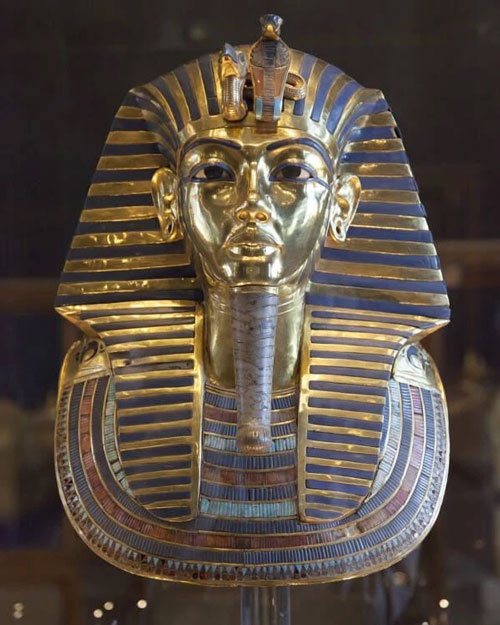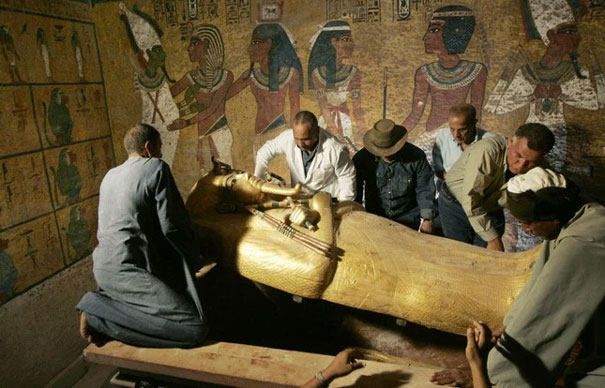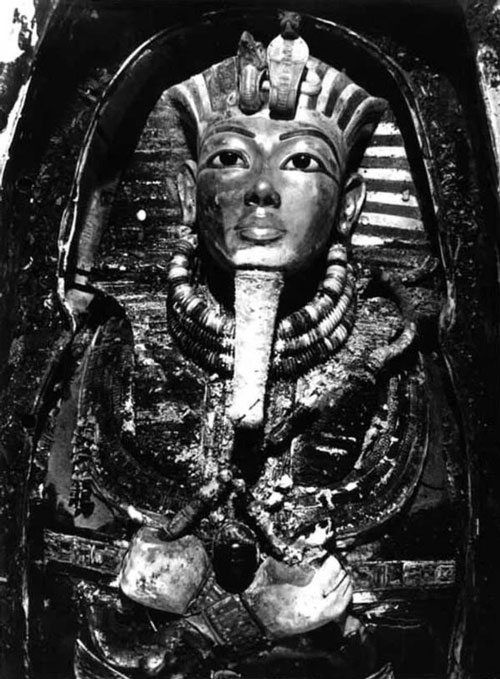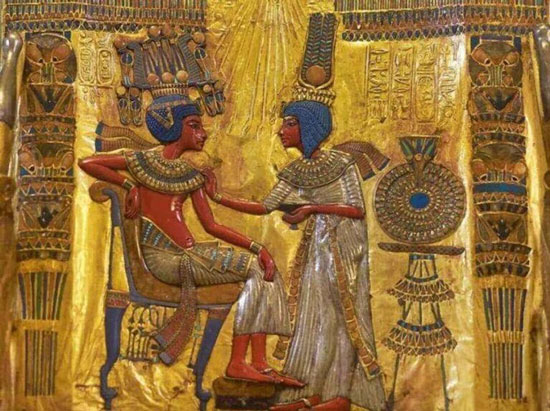Among the thousands of treasures unearthed from the final resting place of King Tut, the golden mask is the most captivating. Beautiful and striking, its dark eyes gaze into our modern world, like a lost guest from the past.
The mask of Pharaoh Tutankhamun was first uncovered when archaeologist Howard Carter opened the tomb of the Egyptian Pharaoh in 1925, and some believe that the ancient tomb unleashed a curse.
When British archaeologists opened the golden sarcophagus of Pharaoh Tutankhamun (also known as King Tut) in 1925, they found themselves staring into the wide eyes of the young king’s mummy mask.
Since then, the mask of King Tut has fascinated the world. With its proud posture, serene gaze, and shining complexion, the gold mask provides a rare glimpse into life during ancient Egypt. It exudes the traditions, beliefs, and artistic capabilities of a glorious culture that has long since vanished.
So who is this young king immortalized in gold? How did archaeologists discover his tomb? And why do some believe this mask was intended for someone else?

King Tut’s mask displayed at the Egyptian Museum in Cairo, Egypt, in 2015. Photo: AP/Getty Images.
By 1922, Howard Carter’s investors were growing impatient. The British archaeologist had scoured the Valley of the Kings in Egypt for eight years without finding anything significant.
The Journey to Discover King Tut’s Mask
Still hopeful of finding the tomb of the young Egyptian king, Tutankhamun, Carter pressured Count Carnarvon for one more year of financial support. Carnarvon reluctantly agreed, with a deadline of just one year.
As time slipped away like sand through fingers, Carter began a new search with renewed intensity. By November 1922, that effort paid off when he discovered a hidden staircase. Carter quickly pulled the string to notify Carnarvon, and the two prepared to break into King Tut’s tomb underground.
With Carter leading the way, the two men stepped across the threshold and into a stifling, dark atmosphere. Howard Carter later wrote: “There, before we could remove the sealed door, and as it opened, we had obliterated centuries of distance and stood before the presence of a king who reigned 3,000 years ago.”
“At first, I saw nothing, the hot air escaping from the room made the candle flicker,” Carter recalled, “but at that moment, as my eyes adjusted to the light, the details of the inner chamber slowly emerged from the mist, strange animals, statues, and gold – everywhere was shimmering gold.”
From behind, Carnarvon asked if Carter saw anything. The archaeologist nearly cried as he replied: “Yes, wonderful things!”

Image of opening King Tutankhamun’s sarcophagus in the tomb in the Valley of the Kings on November 4, 2007. Photo: AFP/GETTY IMAGES
However, among all the “wonderful things” they found, there was certainly one standout – a golden sarcophagus. Three years later, after meticulously documenting thousands of items from the tomb, Carter proceeded to open the sarcophagus for the first time in over 3,000 years.
Carter wrote in his diary after opening the sarcophagus and discovering King Tut’s mask: “The final scene was revealed. A very skillfully wrapped mummy of the young king, with a golden mask that expressed sadness but tranquility… The mask bore the characteristics of a God, but was like Tutankhamun – serene and beautiful, with features similar to those seen on his statues and sarcophagi.”
Subsequent research revealed that King Tut’s mask was made from two types of gold, with the eyes made of obsidian and quartz; the eyebrows and eyelids were adorned with lapis lazuli. The headpiece featured a cobra and a vulture, symbolizing the young king’s control over Upper and Lower Egypt.
But Carter’s discovery was not the end of Pharaoh Tutankhamun’s journey. It was also not the beginning.

King Tut’s mask in 1925, shortly after Carter opened the sarcophagus of the Egyptian Pharaoh. Photo: Howard Carter Archives
Who Was Tutankhamun?
The discovery of King Tut’s mask made Carter famous. It also made King Tut famous, even more so than during his lifetime. So who is this young king with the golden mask?
Born in 1341 BC, Tutankhamun ruled a short, unremarkable dynasty. Ascending to the throne at the age of nine after his father’s death, he seemed to primarily heed the advice of an advisor named Ay.
Although King Tut’s father had ordered the Egyptians to shift to monotheism and worship the sun god Aten, Tutankhamun reversed his father’s edict. Under his reign, the Egyptians returned to polytheistic worship.

Relief of King Tutankhamun and Queen Ankhesenamun. Photo: Wikimedia Commons
King Tut also did not achieve many accomplishments during his reign. He married his half-sister, Ankhesenamun, but they had no heirs – both of their daughters died at birth. In 1324 BC, King Tut’s reign abruptly ended when the young king died at the age of 19.
To this day, no one is certain how Tutankhamun died. CT scans have shown he suffered from malaria, a broken leg, and due to incestuous marriage within the family, he had congenital deformities. King Tut also walked with a clubfoot and had to use a cane. But whether this Pharaoh died naturally, from an accident, or was assassinated remains unclear.
What is known is that the young Pharaoh was honored in death. After being mummified and placed in a golden sarcophagus, King Tut’s mask was placed on the mummy. His sarcophagus was then lowered into the tomb with thousands of treasures, a staff, and the remains of his two daughters.
He remained there for 3,000 years, until one day in November 1925 when Carter and Carnarvon walked in.
The Legacy of King Tut’s Mask
Since Howard Carter opened the tomb of Tutankhamun, the young king has traveled the world more than he ever did in life. King Tut and his golden mask have been exhibited in France, England, Japan, Russia, and the United States.
However, King Tut’s globe-trotting was not without controversy.
First, the young king’s remains were shrouded in suspicion of a curse. Carter was fortunate to escape the curse, but Carnarvon died shortly after the tomb of King Tut was opened. He succumbed to blood poisoning from a mosquito bite.
Other associates of Carnarvon who entered the tomb also experienced strange fates. One man died of respiratory failure. Another died in a fire. And one even hanged himself out of fear that the curse would come for him.
Setting the curse aside, some have questioned whether the mask belonged to King Tut. Some British Egyptologists believe the mask was originally made for Nefertiti, the chief wife of Pharaoh Akhenaten (or Amenhotep IV) – who was Tutankhamun’s father. They reached this conclusion partly because King Tut’s mask appears to be wearing earrings.
However, Egyptologists have largely dismissed this theory. In King Tut’s time, earrings were not exclusively for women or children, and there is evidence that the mask was specifically made for him.
Egyptologist Bassam al-Shamaa explains: “The golden mask has a hieroglyphic inscription, a type of magical writing akin to a spell, designed to help the deceased navigate the afterlife.”
Today, the life and death of Pharaoh Tutankhamun continue to captivate the public. 3,000 years after his passing and nearly 100 years after his sarcophagus was opened, museum visitors remain eager to view artifacts from his tomb.


















































